

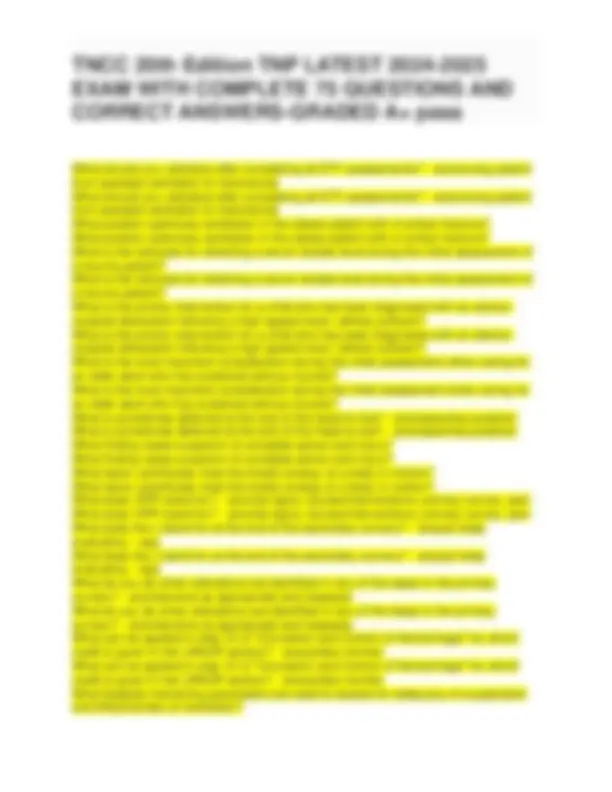
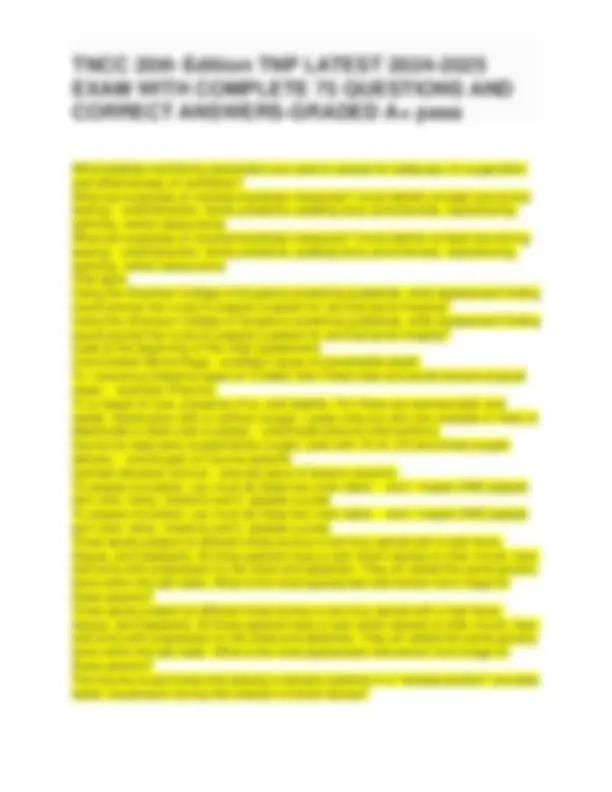
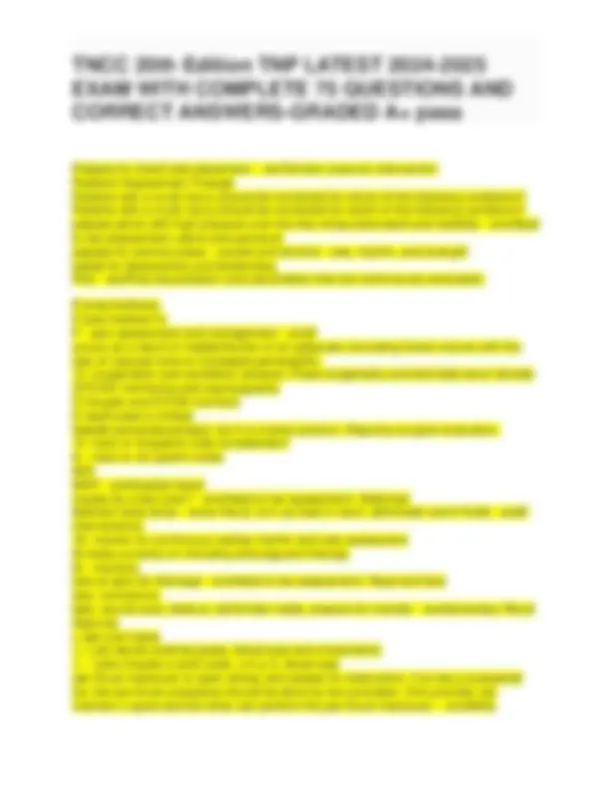
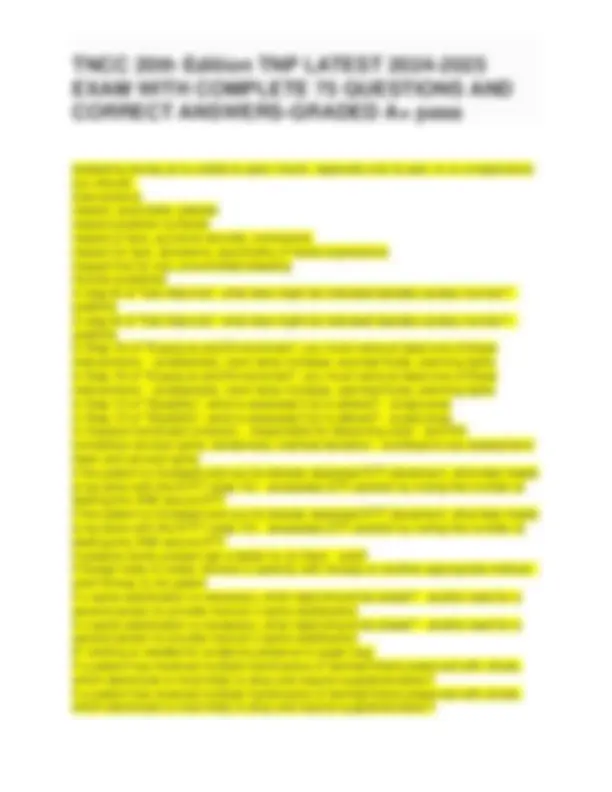


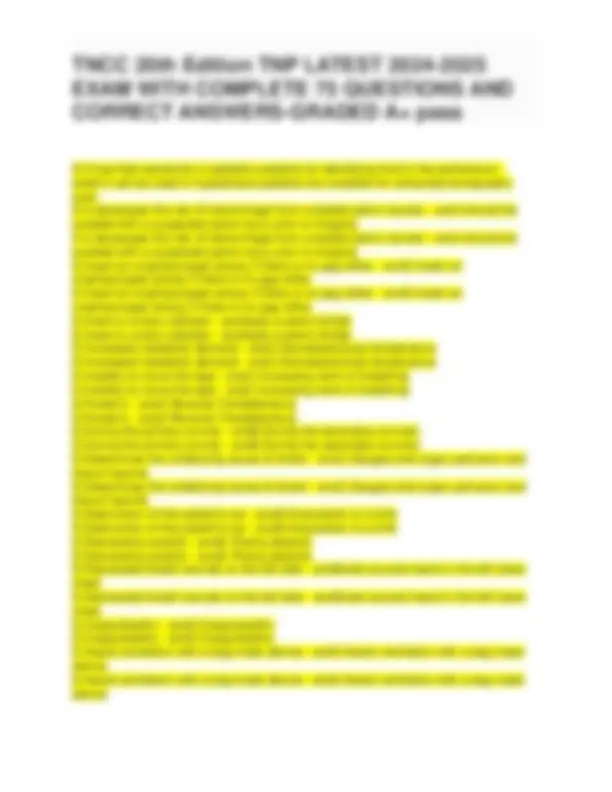
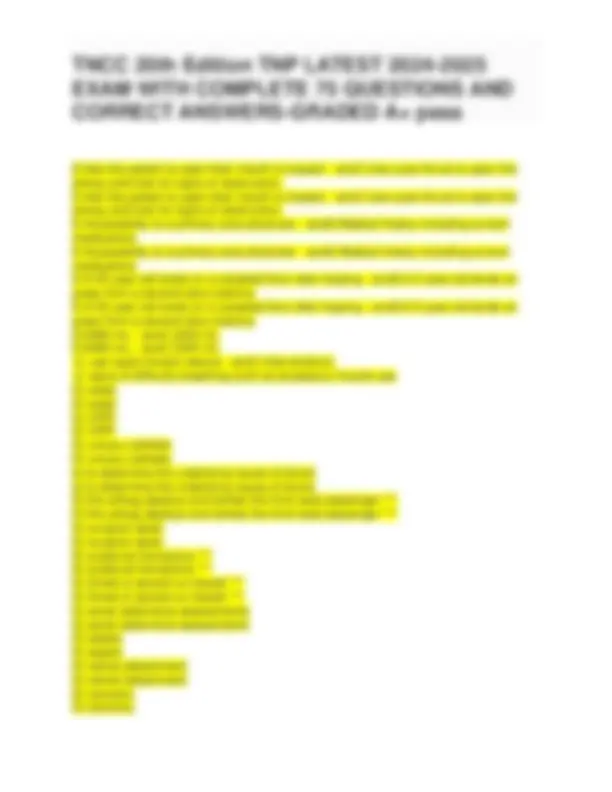
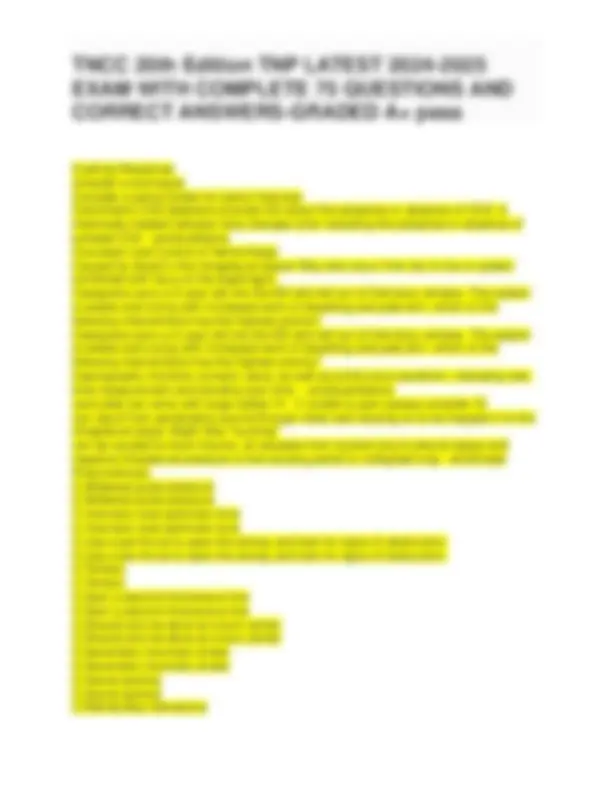

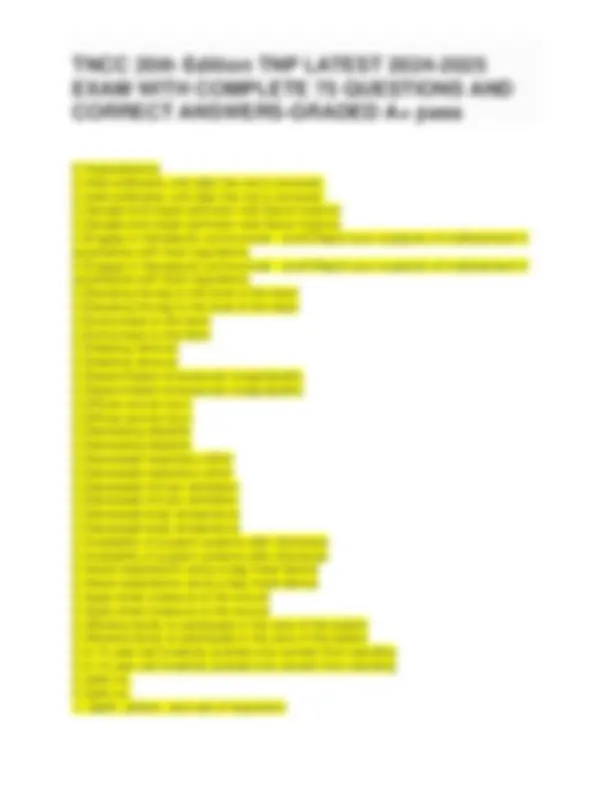
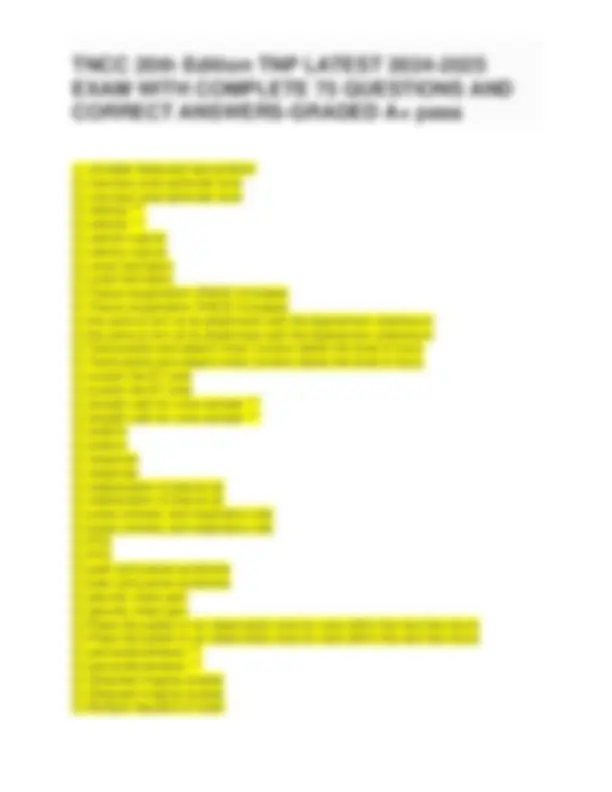



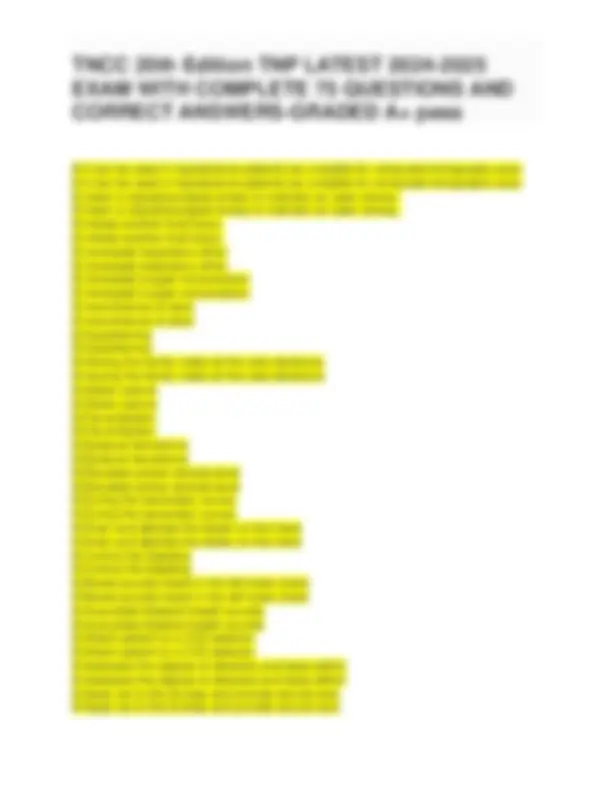

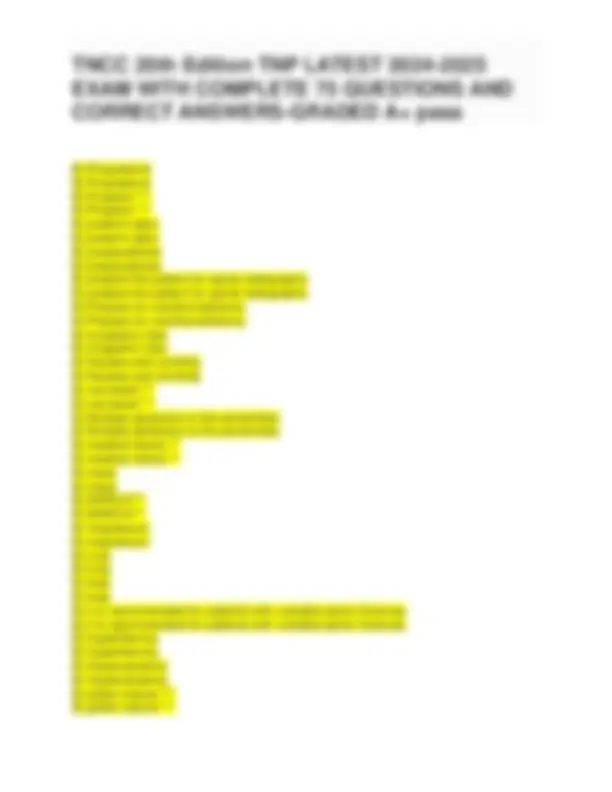

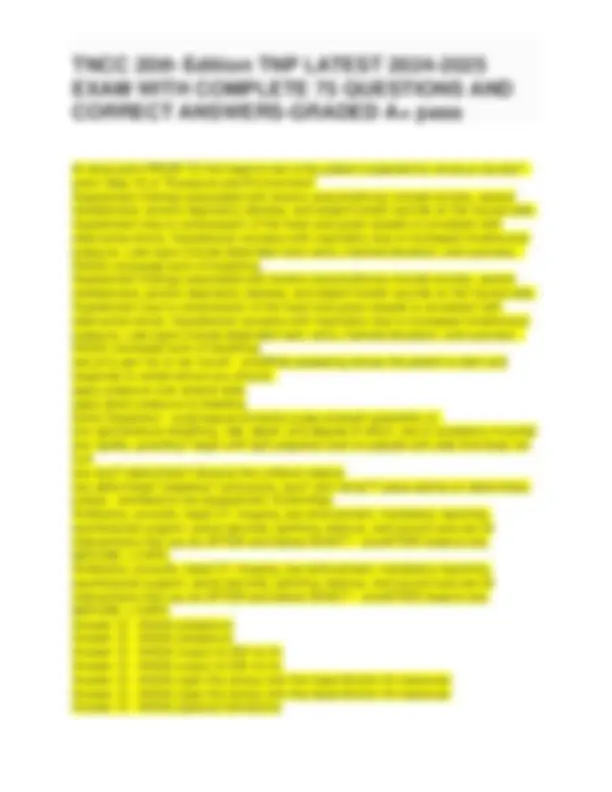
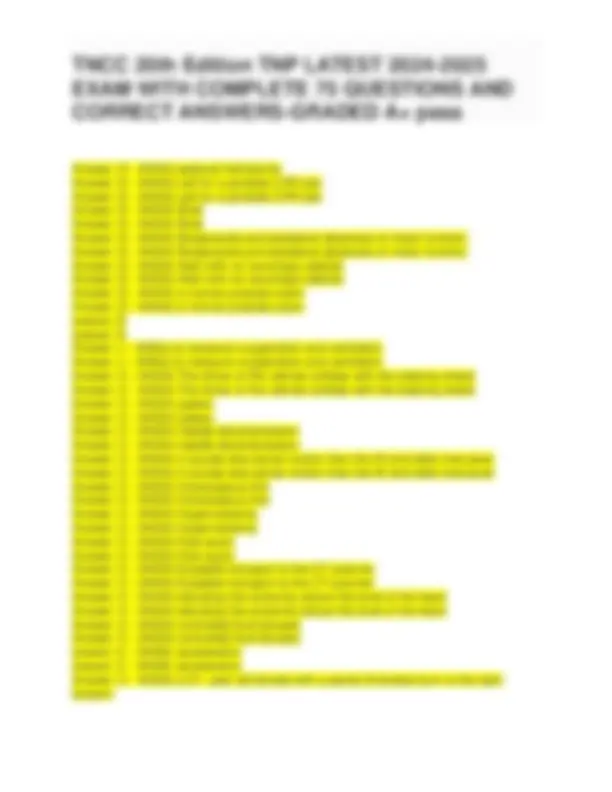
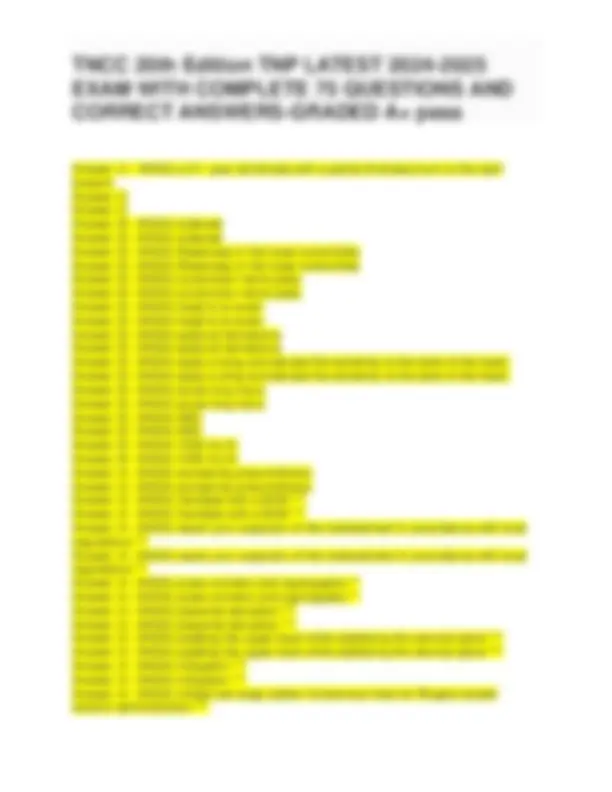
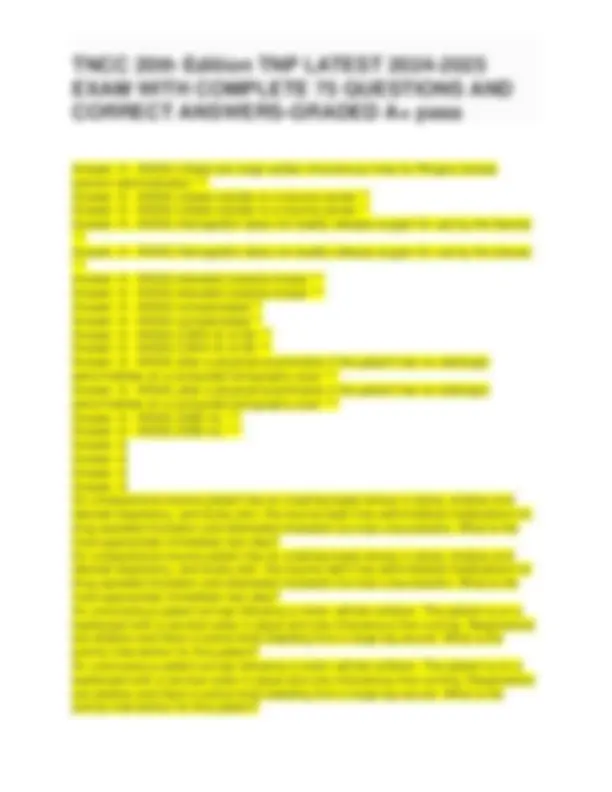


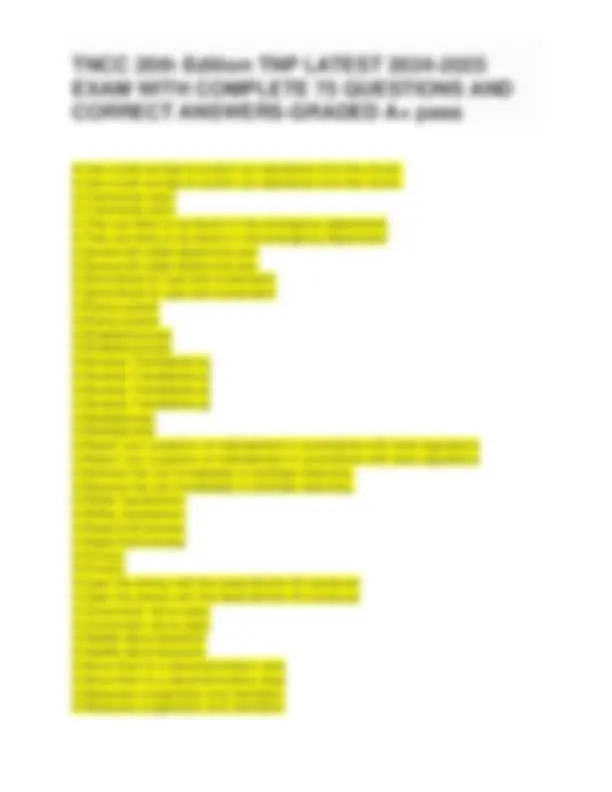

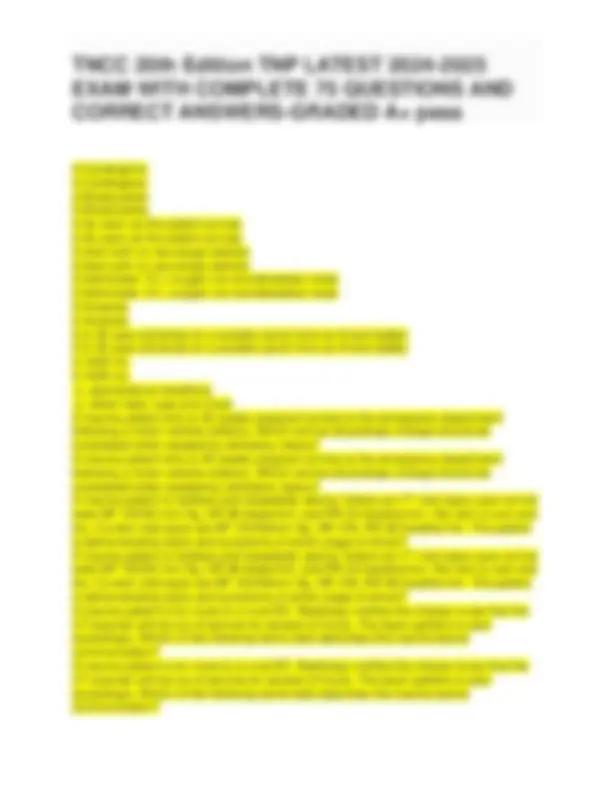
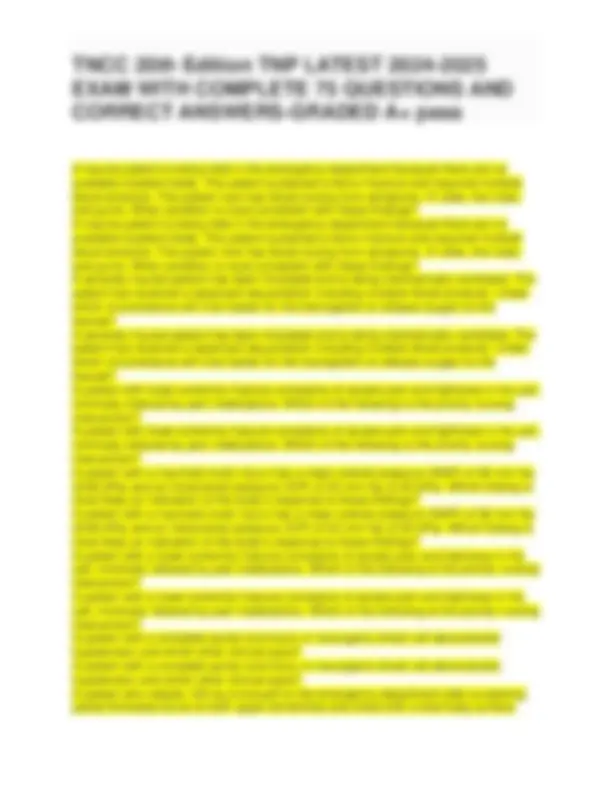
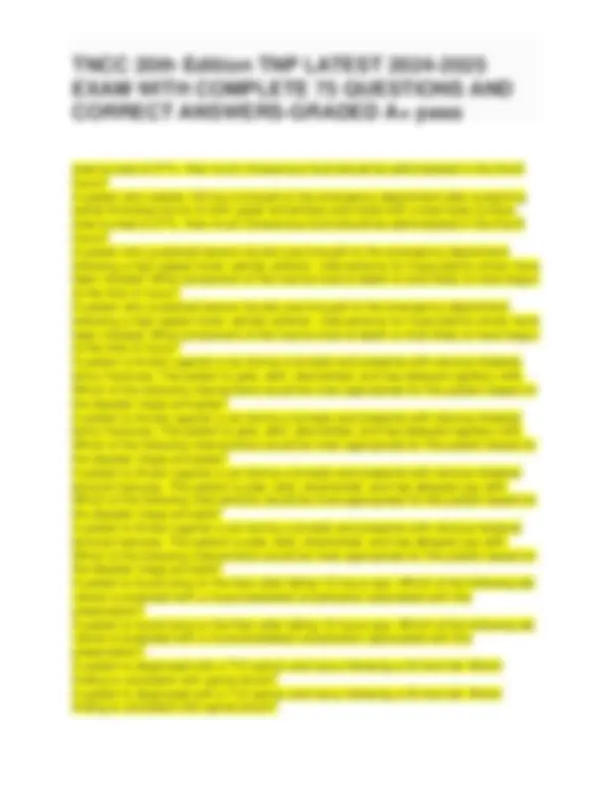
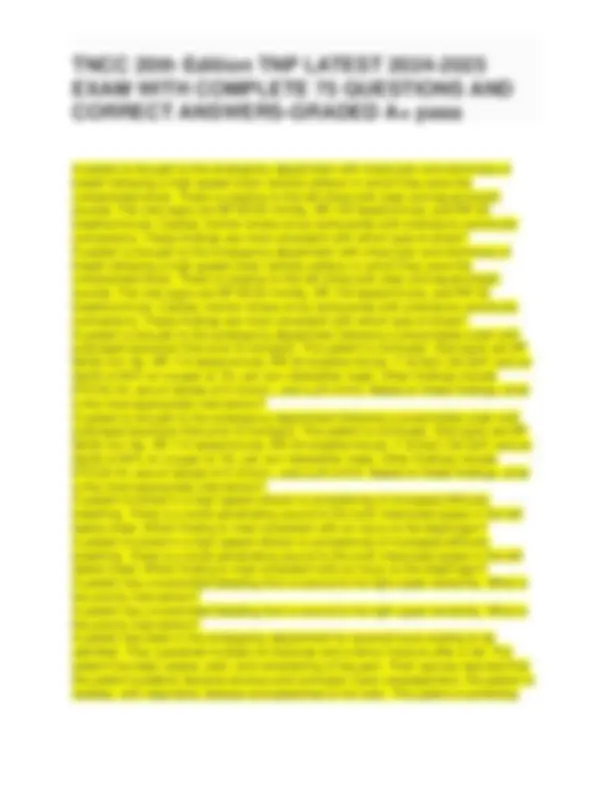


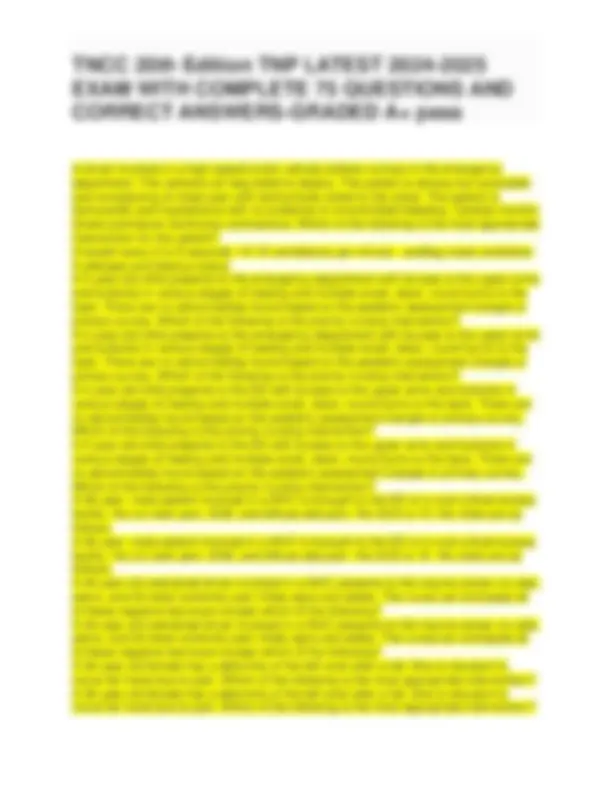
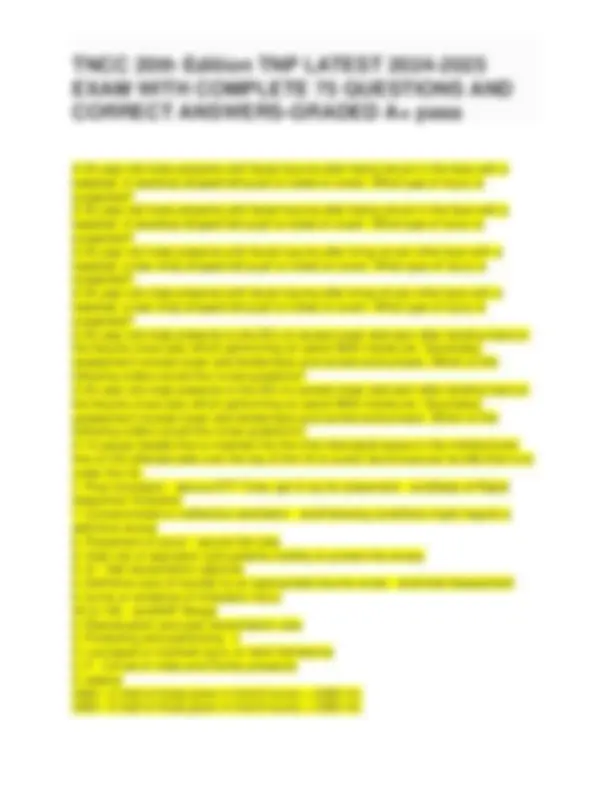


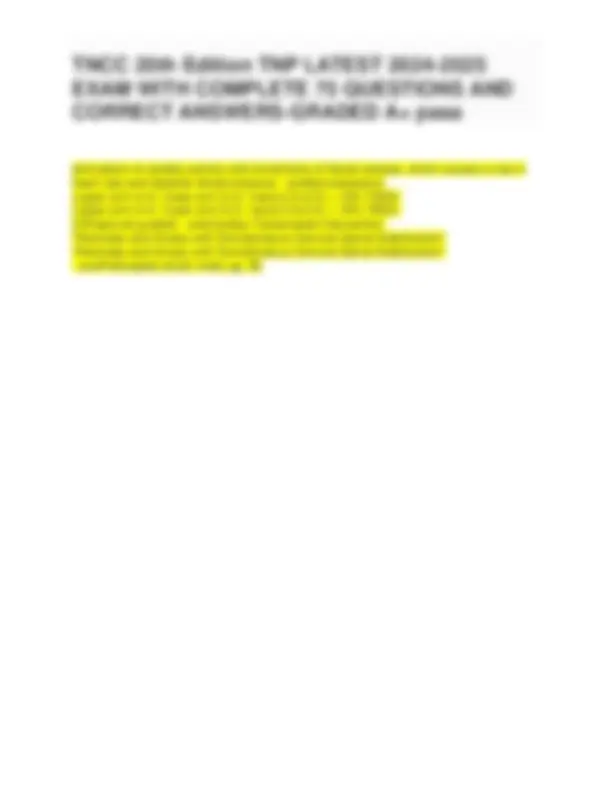
















Study with the several resources on Docsity

Earn points by helping other students or get them with a premium plan


Prepare for your exams
Study with the several resources on Docsity

Earn points to download
Earn points by helping other students or get them with a premium plan
Community
Ask the community for help and clear up your study doubts
Discover the best universities in your country according to Docsity users
Free resources
Download our free guides on studying techniques, anxiety management strategies, and thesis advice from Docsity tutors
TNCC 20th Edition TNP LATEST 2025-2026 EXAM WITH COMPLETE 75 QUESTIONS AND CORRECT ANSWERS-GRADED A+ pass.pdf
Typology: Exams
1 / 61

This page cannot be seen from the preview
Don't miss anything!






















































Your patient was the unrestrained driver involved in a moderate speed motor vehicle collision. Assessment reveals tenderness in the upper right quadrant, crepitus in the lower right ribs, and ecchymosis around the umbilicus. The nurse is concerned about injury to which organ? Your patient was the unrestrained driver involved in a moderate speed motor vehicle collision. Assessment reveals tenderness in the upper right quadrant, crepitus in the lower right ribs, and ecchymosis around the umbilicus. The nurse is concerned about injury to which organ? Your patient is a pedestrian struck by a car and thrown 35 feet. They were unconscious at the scene but became responsive with initial and subsequent Glasgow Coma Scale (GCS) scores of 13 (E-3, V-4, M-6). The patient has bilateral subdural hematomas and is awaiting transfer to the ICU. Your next assessment reveals a GCS of 9 (E-2, V-2, M- 5). What is the priority nursing intervention? Your patient is a pedestrian struck by a car and thrown 35 feet. They were unconscious at the scene but became responsive with initial and subsequent Glasgow Coma Scale (GCS) scores of 13 (E-3, V-4, M-6). The patient has bilateral subdural hematomas and is awaiting transfer to the ICU. Your next assessment reveals a GCS of 9 (E-2, V-2, M- 5). What is the priority nursing intervention? You are treating a 27-year old male in respiratory distress who was involved in a house fire. Calculating TBSA burned is deferred d/t the need for emergent intubation. At what rate should you begin fluid resuscitation? You are treating a 27-year old male in respiratory distress who was involved in a house fire. Calculating TBSA burned is deferred d/t the need for emergent intubation. At what rate should you begin fluid resuscitation? You are caring for a patient who was involved in a MVA and is 32 weeks pregnant. Findings of your secondary survey include abd pain on palpation, fundal high at the costal margin, and some dark bloody show. Varying, accelerations and decelerations are noted on the cardiotocography. These findings are most consistent with which of the following? You are caring for a patient who was involved in a MVA and is 32 weeks pregnant. Findings of your secondary survey include abd pain on palpation, fundal high at the costal margin, and some dark bloody show. Varying, accelerations and decelerations are noted on the cardiotocography. These findings are most consistent with which of the following? Widening pulse pressure Widening pulse pressure Why is a measure of serum lactate obtained in the initial assessment of the trauma patient? Why is a measure of serum lactate obtained in the initial assessment of the trauma patient?
While caring for a trauma patient in the emergency department, what finding raises suspicion of a complete spinal cord injury? While caring for a trauma patient in the emergency department, what finding raises suspicion of a complete spinal cord injury? While caring for a child who has been injured, what nursing intervention is consistent with a family-center approach? While caring for a child who has been injured, what nursing intervention is consistent with a family-center approach? Which pulse pressure description is an indication of early hypovolemic shock? Which pulse pressure description is an indication of early hypovolemic shock? Which of the following situations could cause functional grief? Which of the following situations could cause functional grief? Which of the following patients warrants referral to a burn center? Which of the following patients warrants referral to a burn center? Which of the following occurs during the third impact of a motor vehicle crash? Which of the following occurs during the third impact of a motor vehicle crash? Which of the following mnemonics can help the nurse prioritize care for a trauma patient with massive uncontrolled hemorrhage? Which of the following mnemonics can help the nurse prioritize care for a trauma patient with massive uncontrolled hemorrhage? Which of the following is true about use of the focused assessment sonography for trauma exam for a patient with abdominal trauma? Which of the following is true about use of the focused assessment sonography for trauma exam for a patient with abdominal trauma? Which of the following is true about the log-roll maneuver? Which of the following is true about the log-roll maneuver? Which of the following is true about the log roll maneuver? Which of the following is true about the log roll maneuver? which of the following is the priority intervention for this patient? which of the following is the priority intervention for this patient? Which of the following is possible complication of positive-pressure ventilation? Which of the following is possible complication of positive-pressure ventilation? Which of the following is NOT considered goal-directed therapy of cardiogenic shock? Which of the following is NOT considered goal-directed therapy of cardiogenic shock? Which of the following is an expected finding in a patient with a thoracostomy connected to a chest drainage system? Which of the following is an expected finding in a patient with a thoracostomy connected to a chest drainage system? Which of the following is a late sign of increased intracranial pressure? Which of the following is a late sign of increased intracranial pressure?
What should you verbalize after completing all ETT assessments? - ansmoving patient from assisted ventilation to mechanical What should you verbalize after completing all ETT assessments? - ansmoving patient from assisted ventilation to mechanical What position optimizes ventilation in the obese patient with a lumbar fracture? What position optimizes ventilation in the obese patient with a lumbar fracture? What is the rationale for obtaining a serum lactate level during the initial assessment of a trauma patient? What is the rationale for obtaining a serum lactate level during the initial assessment of a trauma patient? What is the priority intervention for a child who has been diagnosed with an atlanto- occipital dislocation following a high-speed motor vehicle collision? What is the priority intervention for a child who has been diagnosed with an atlanto- occipital dislocation following a high-speed motor vehicle collision? What is the most important consideration during the initial assessment when caring for an older adult who has sustained serious injuries? What is the most important consideration during the initial assessment when caring for an older adult who has sustained serious injuries? What is sometimes deferred at the end of the head-to-toe? - ansinspecting posterior What is sometimes deferred at the end of the head-to-toe? - ansinspecting posterior What finding raises suspicion of complete spinal cord injury? What finding raises suspicion of complete spinal cord injury? What factor contributes most the kinetic energy of a body in motion? What factor contributes most the kinetic energy of a body in motion? What does VIPP stand for? - ansvital signs, injuries/interventions, primary survey, pain What does VIPP stand for? - ansvital signs, injuries/interventions, primary survey, pain What does the J stand for at the end of the secondary survery? - ansjust keep evaluating - vipp What does the J stand for at the end of the secondary survery? - ansjust keep evaluating - vipp What do you do when alterations are identified in any of the steps in the primary survery? - ansintervene as appropriate and reassess What do you do when alterations are identified in any of the steps in the primary survery? - ansintervene as appropriate and reassess What can be applied in step 12 of "Circulation and Control of Hemorrhage" for which credit is given in the LMNOP section? - anscardiac monitor What can be applied in step 12 of "Circulation and Control of Hemorrhage" for which credit is given in the LMNOP section? - anscardiac monitor What bedside monitoring parameters are used to assess for adequacy of oxygenation and effectiveness of ventilation?
What bedside monitoring parameters are used to assess for adequacy of oxygenation and effectiveness of ventilation? What are examples of nonpharmacologic measures? (must identify at least one during testing) - ansDistraction, family presence, padding bony prominences, repositioning, splinting, verbal reassurance What are examples of nonpharmacologic measures? (must identify at least one during testing) - ansDistraction, family presence, padding bony prominences, repositioning, splinting, verbal reassurance Vital signs Using the American College of Surgeons screening guidelines, what assessment finding would prompt the nurse to prepare a patient for cervical spine imaging? Using the American College of Surgeons screening guidelines, what assessment finding would prompt the nurse to prepare a patient for cervical spine imaging? Used at the beginning of the initial assessment Uncontrolled Hemorrhage - ansMajor cause of preventable death: Tx: nonporous dressing tapes on 3 sided, then Chest tube and would closure surgical repair. - ansOpen Pneumo: Tx is based on size, presence of sx, and stability. For those are aysmpomatic and stable. Observation with or without oxygen. Larger pneumo who are unstable or likely to deteriorate a chest tube is placed. - ansSimple pneumo interventions: trauma its need early supplemental oxygen, start with 15 mL O2 and titrate oxygen delivery. - ansOxygen on trauma patients tracheal deviation and jvd - ansLate signs of tension pneumo: To assess circulation, you must do these two main tasks: - ans1. inspect AND palpate skin color, temp, moisture and 2. palpate a pulse To assess circulation, you must do these two main tasks: - ans1. inspect AND palpate skin color, temp, moisture and 2. palpate a pulse Three adults present at different times during a one-hour period with a high fever, fatigue, and headache. All three patients have a rash which started on their mouth, face, and arms with progression to the chest and abdomen. They all visited the same grocery store within the last week. What is the most appropriate intervention from triage for these patients? Three adults present at different times during a one-hour period with a high fever, fatigue, and headache. All three patients have a rash which started on their mouth, face, and arms with progression to the chest and abdomen. They all visited the same grocery store within the last week. What is the most appropriate intervention from triage for these patients? The trauma nurse knows that placing a bariatric patients in a "ramped position" provides better visualization during the insertion of which device?
patients who are hemodynamically unstable after trauma. - ANSA) diagnostic peritoneal lavage *** the decrease coagulopathy .. you will you bleed more - ansThe colder you are the more acidic you are.. Tearing of the bridging veins is most frequently associated with which brain injury? Tearing of the bridging veins is most frequently associated with which brain injury? take out backboard T treatment in the field Stroke Volume X HR - ansCardiac Output = stabilized vital signs, improved mental status, improved urine output - ansWhat are indicators of increased perfusion? SpO2 94% on high flow O2 via NRB mask SpO2 94% on high flow O2 via NRB mask Skin temp: cool, diaphoretic, or warm and dry - ansC Skin color Septic Shock - systemic release of bacterial endotoxins, resulting in increased vascular permeability and vasodilation. Neurogenic shock - spinal cord injury results of loss in sympathetic nervous system control of vascular tone. Sample is part of history S symptoms associated with injury S s/s in the field RR 26 breaths/min RR 26 breaths/min Results from pump failure in the presence of adequate intravascular volume. There is a lack of cardiac output and end organ perfusion secondary to a decrease in myocardial contractility and/or valvular insufficiency. results from hypo perfusion to the tissue due to an obstruction in either vasculature or heart. Goal is to relieve obstruction and improve perfusion. reorganize care to C-ABC - ansIf uncontrolled hemorrhage .. Remove all clothes and assess for any obvious injuries and uncontrolled bleeding - ansE Reflex bradycardia Reflex bradycardia Reevaluation and Consider the need to Transfer - ansFinal step in primary survey Rectal tone per MD - ansI Pt is at hospital in the right amount of time, right care, right trauma facility, right resources - ansSafe Care: Primary survey Prepare for thoracentesis and chest tube insertion. If open thoracotomy is done chest tube is deferred. - ansHemothorax:
Prepare for chest tube placement. - ansTension pneumo intervention Pediatric Assessment Triangle Patients with a crush injury should be monitored for which of the following conditions? Patients with a crush injury should be monitored for which of the following conditions? palpate pelvis with high pressure over the iliac wings downward and medially - ansHead to toe assessment: pelvis and perineum palpate for central pulses - carotid and femoral - rate, rhythm, and strength palate for depressions and tenderness Pain - ansPost resuscitation care parameters that are continuously evaluated: P pneumothorax P past medical hx P - pain assessment and management - ansG occurs as a result of maldistribution of an adequate circulating blood volume with the loss of vascular tone or increased permeability. O- oxygenation and ventilation analysis: Pulse oxygemetry and end-tidal caron dioxide (ETC02) monitoring and capnopgraphy O Oxygen and ETC02 monitors O obstructed or kinked Needle pericardiocentesis, but it is a temp solution. Requires surgical evaluation. N- naso or orogastric tube consideration N - naso or oro gastric tubes MOI MIST - prehospital report maybe do a fast scan? - ansHead to toe assessment: Abdomen Maintain body temp - cover the pt, turn up heat in room, administer warm fluids - ansE Interventions: M- monitor for continuous cardiac rhythm and rate assessment M meds currently on including anticoagulant therapy M - monitors look at ears for drainage - ansHead to toe assessment: Head and face lacs, contusions, labs, wound care, tetanus, administer meds, prepare for transfer - ansSecondary Reval Adjuncts L last oral intake L- Lab results (arterial gases, blood type and crossmatch) L - Labs (maybe a lactic acid), a b g 's, blood type jaw thrust maneuver to open airway and assess for obstruction. If pt has a suspected csi, the jaw thrust procedure should be done by two providers. One provider can maintain c-spine and the other can perform the jaw thrust maneuver. - ansWhile
i. signs of inhalation injury (singed nasal hairs, carbonaceous sputum) - ansB I- Inspect posterior surfaces - ansABCDEFGHI hypothermia, metabolic acidosis, coagulopathy - ANSA) Acidosis ** hypothermia, metabolic acidosis, coagulopathy - ANSA) Acidosis ** HR 125 beats/min HR 125 beats/min History and Head to toe h. JVD H,I - ansSecondary Survery H- History and head to toe assessment Goal: Volume replacement and vasoconstriction - ansDistributive Shock Get Resuscitation Adjuncts g. open pneumothoraces (sucking chest wounds) Full set of vitals and family presence - ansF from hemorrhage is leading cause. Hypovolemia is caused by decrease in the amount of circulating volume. Goal is to replace volume. - ansHypovolemic Shock Four of these must be identified to assess patency and protection of the airway: - ansbony deformity, loose teeth, edema, inhalation injury, sounds, tongue obstruction, burns, fluids, foreign objects, vocalization Four of these must be identified to assess patency and protection of the airway: - ansbony deformity, loose teeth, edema, inhalation injury, sounds, tongue obstruction, burns, fluids, foreign objects, vocalization Four of these must be identified to assess breathing effectiveness: - ansBreath sounds, depth/pattern/rate, spontaneous breathing, subcutaneous emphysema, increased work of breathing, symmetrical chest rise and fall, tracheal deviation/JVD, open wounds/deformities, skin color Four of these must be identified to assess breathing effectiveness: - ansBreath sounds, depth/pattern/rate, spontaneous breathing, subcutaneous emphysema, increased work of breathing, symmetrical chest rise and fall, tracheal deviation/JVD, open wounds/deformities, skin color For whom is capnography highly recommended? - ansall patients For whom is capnography highly recommended? - ansall patients Following a review of recent drills and a real disaster event, a hospital has identified deficiencies and is taking steps to minimize the impact of future disaster. Which phase of the disaster life cycle does this describe? Following a review of recent drills and a real disaster event, a hospital has identified deficiencies and is taking steps to minimize the impact of future disaster. Which phase of the disaster life cycle does this describe?
Following a gun shot wound, pre-hospital providers report diminished breath sounds bilaterally. Upon emergency department arrival, the patient is unresponsive with shallow respirations and an O2 sat of 88%. What is the priority intervention for this patient? Following a gun shot wound, pre-hospital providers report diminished breath sounds bilaterally. Upon emergency department arrival, the patient is unresponsive with shallow respirations and an O2 sat of 88%. What is the priority intervention for this patient? Flail chest - ansParadoxical chest wall movement f. contusions, abrasions, deformities (flail chest) Exposure and Environmental Control Ex: tension pneumo or cardiac tamponade are two classic examples that may result from trauma. - ansObstructive Shock Ex: MI's or dysrhythmia are common causes - ansCariogenic Shock Ex: Anaphylactic - release of antihistamines Ensure two large bore IVS are placed. EMS brings a patient who fell riding his bicycle. Using the American College of Surgeons screening guidelines, which assessment finding would prompt the nurse to prepare the patient for radiologic spine clearance? EMS brings a patient who fell riding his bicycle. Using the American College of Surgeons screening guidelines, which assessment finding would prompt the nurse to prepare the patient for radiologic spine clearance? EMS arrives with the intoxicated driver of a car involved in a MVC. EMS reports significant damage to the drivers side of the car. The patient is asking to have the cervical color removed. when is it appropriate to remove the cervical collar? EMS arrives with the intoxicated driver of a car involved in a MVC. EMS reports significant damage to the drivers side of the car. The patient is asking to have the cervical color removed. when is it appropriate to remove the cervical collar? elevate extremity e. skin color (normal, pale, flushed, cyanotic) E Events and environment factors related to the injury - ansSAMPLE E equipment failure , such as becoming detached from the equipment or loss of capnopgrahy - ansDOPE During which part of the primary survey would you anticipate the need for a chest tube, intubation, decompression of pneumothorax, oxygen, or BVMs? - ans"Breathing and Ventilation" During which part of the primary survey would you anticipate the need for a chest tube, intubation, decompression of pneumothorax, oxygen, or BVMs? - ans"Breathing and Ventilation" During which part of the primary survey would there be anticipation for intubation, insertion of OPA/NPA, removal of any loose teeth or foreign objects, or suctioning? - ansAssessing patency and protection of the airway, Step 7 of
D.Spleen - ansC.Liver D.Spastic paralysis of the legs - ansurinary incontinence D.Spastic paralysis of the legs - ansurinary incontinence D.Slower desaturation rates with apnea - ansB.Increased oxygen consumption D.Slower desaturation rates with apnea - ansB.Increased oxygen consumption D.Retinal detachment - ansGlobe rupture D.Retinal detachment - ansGlobe rupture D.Responds to verbal stimulation - ansA.Alert with no neurologic deficits D.Responds to verbal stimulation - ansA.Alert with no neurologic deficits D.Quaternary - ansC.Tertiary D.Quaternary - ansC.Tertiary D.Preparing the patient for ultrasound of the leg - ansC.Elevating the leg to the level of the heart D.Preparing the patient for ultrasound of the leg - ansC.Elevating the leg to the level of the heart D.Prepare the patient for surgery to remove the rod. - ansD.Prepare the patient for surgery to remove the rod. D.Prepare the patient for surgery to remove the rod. - ansD.Prepare the patient for surgery to remove the rod. D.Post-concussive syndrome - anspost-concussive syndrome D.Post-concussive syndrome - anspost-concussive syndrome D.Place the patie - ansB.Notify the provider of the change D.Place the patie - ansB.Notify the provider of the change D.Numbness to the perianal area - ansVoluntary anal sphincter tone D.Numbness to the perianal area - ansVoluntary anal sphincter tone D.Narrowing pulse pressure - ansC.Decreased respiratory effort D.Narrowing pulse pressure - ansC.Decreased respiratory effort D.Multiple organ dysfunctions syndrome - ansC.Disseminated intravascular coagulopathy D.Multiple organ dysfunctions syndrome - ansC.Disseminated intravascular coagulopathy D.Moral injury - ansD.Moral injury D.Moral injury - ansD.Moral injury D.Limiting dissemination of complex information - ansC.Allowing family to participate in the care of the patient D.Limiting dissemination of complex information - ansC.Allowing family to participate in the care of the patient D.It has high sensitivity in pediatric patients for identifying fluid in the peritoneum - ansB.It can be used in hypotensive patients too unstable for computed tomography scan
D.It has high sensitivity in pediatric patients for identifying fluid in the peritoneum - ansB.It can be used in hypotensive patients too unstable for computed tomography scan D.It decreases the risk of hemorrhage from unstable pelvic injuries - ansIt should be avoided with a suspected spine injury prior to imaging D.It decreases the risk of hemorrhage from unstable pelvic injuries - ansIt should be avoided with a suspected spine injury prior to imaging D.Insert an oropharyngeal airway if there is no gag reflex - ansD.Insert an oropharyngeal airway if there is no gag reflex D.Insert an oropharyngeal airway if there is no gag reflex - ansD.Insert an oropharyngeal airway if there is no gag reflex D.Insert a urinary catheter - ansApply a pelvic binder D.Insert a urinary catheter - ansApply a pelvic binder D.Increased metabolic demand - ansC.Decreased body temperature D.Increased metabolic demand - ansC.Decreased body temperature D.Inability to move the legs - ansC.Increasing work of breathing D.Inability to move the legs - ansC.Increasing work of breathing D.Fowler's - ansA.Reverse Trendelenburg D.Fowler's - ansA.Reverse Trendelenburg D.During the primary survey - ansB.During the secondary surveyt D.During the primary survey - ansB.During the secondary surveyt D.Determines the underlying cause of shock - ansC.Gauges end-organ perfusion and tissue hypoxia D.Determines the underlying cause of shock - ansC.Gauges end-organ perfusion and tissue hypoxia D.Destruction of the patient's car - ansB.Amputation of a limb D.Destruction of the patient's car - ansB.Amputation of a limb D.Decreasing systolic - ansB. Rising diastolic D.Decreasing systolic - ansB. Rising diastolic D.Decreased breath sounds on the left side - ansBowel sounds heard in the left lower chest D.Decreased breath sounds on the left side - ansBowel sounds heard in the left lower chest D.Coagulopathy - ansD.Coagulopathy D.Coagulopathy - ansD.Coagulopathy D.Assist ventilation with a bag-mask device - ansD.Assist ventilation with a bag-mask device D.Assist ventilation with a bag-mask device - ansD.Assist ventilation with a bag-mask device
D) pulmonary contusion D) pulmonary contusion D) provide the family with injury prevention resourse D) provide the family with injury prevention resourse D) Preparing the patient for ultrasound D) Preparing the patient for ultrasound D) preparing for drug assisted intubation D) preparing for drug assisted intubation D) polyuria D) polyuria D) Place a gastric tube D) Place a gastric tube D) pelvic stability *** D) pelvic stability *** D) notify the patients family D) notify the patients family D) negative intrapleural pressure D) negative intrapleural pressure D) it does not increases the risk of life threatening hemorrhage from unstable injuries D) it does not increases the risk of life threatening hemorrhage from unstable injuries D) intracerebral hematoma D) intracerebral hematoma D) intact reflexes distal to the injury D) intact reflexes distal to the injury D) insert an oropharyngeal airway if there is no gag reflex *** D) insert an oropharyngeal airway if there is no gag reflex *** D) inertia D) inertia D) ice and elevation of the scrotum D) ice and elevation of the scrotum D) hypotension that worsens with inspiration *** D) hypotension that worsens with inspiration *** D) huddle *** D) huddle *** D) Hemoglobin molecule saturation (SaO2) decreases D) Hemoglobin molecule saturation (SaO2) decreases D) heart rate of 45 beats/min D) heart rate of 45 beats/min D) fluctuations in the water serial chamber *** D) fluctuations in the water serial chamber ***
D) fetal demise D) fetal demise D) falls D) falls D) elevated GFR D) elevated GFR D) decompensated D) decompensated D) Contact the command center for the personnel to notify next of kin. D) Contact the command center for the personnel to notify next of kin. D) contact anesthesia for assistance D) contact anesthesia for assistance D) confirm ET tube placement D) confirm ET tube placement D) cardiac cath D) cardiac cath D) capnography and capnometry D) capnography and capnometry D) calcium *** D) calcium *** D) brain D) brain D) Bradycardia and absent motor function below the level of the injury *** D) Bradycardia and absent motor function below the level of the injury *** D) apply a splint and elevate the extremity to the level of the heart. D) apply a splint and elevate the extremity to the level of the heart. D) amnesia and anxiety D) amnesia and anxiety D) after physical examination if the patient has not neck pain with movement D) after physical examination if the patient has not neck pain with movement D) a 35-year old hyperlipidemic female with superficial burns to the anterior thorax. D) a 35-year old hyperlipidemic female with superficial burns to the anterior thorax. D) 7680 mL D) 7680 mL D) 125 mL/hr D) 125 mL/hr D displaced tube Cushing Response
C.Retrobulbar hematoma C.Repeat the GCS in 30 minutes C.Repeat the GCS in 30 minutes C.Reflex tachycardia C.Reflex tachycardia C.Re - ansA.Decrease the rate of manual ventilation. C.Re - ansA.Decrease the rate of manual ventilation. C.Ramped C.Ramped C.Prone C.Prone C.Prepare the patient for surgery C.Prepare the patient for surgery C.Prepare for a definitive airway C.Prepare for a definitive airway C.Placing the patient on pulse oximetry C.Placing the patient on pulse oximetry C.Place the patient in an observation area for care within the n - ansInitiate two large- caliber intravenous lines for isotonic crystalloid administration. C.Place the patient in an observation area for care within the n - ansInitiate two large- caliber intravenous lines for isotonic crystalloid administration. C.Pain radiating to the left shoulder. C.Pain radiating to the left shoulder. C.Loss of one's self-image C.Loss of one's self-image C.Liver C.Liver C.It should be avoided with a suspected spine injury prior to imaging C.It should be avoided with a suspected spine injury prior to imaging C.It can detect as little as 30 mL of fluid in the abdominal cavity C.It can detect as little as 30 mL of fluid in the abdominal cavity C.Increasing work of breathing C.Increasing work of breathing C.Immerse in water between 37.5 - ansD.Gently rewarm over 15 to 30 minutes C.Immerse in water between 37.5 - ansD.Gently rewarm over 15 to 30 minutes C.Immediately initiate isolation precautions - ansImmediately initiate isolation precautions C.Immediately initiate isolation precautions - ansImmediately initiate isolation precautions C.Hypocalcemia
C.Hypocalcemia C.Hold antibiotics until after the rod is removed. C.Hold antibiotics until after the rod is removed. C.Gauges end-organ perfusion and tissue hypoxia C.Gauges end-organ perfusion and tissue hypoxia C.Engage in therapeutic communicati - ansA.Report your suspicion of maltreatment in accordance with local regulations C.Engage in therapeutic communicati - ansA.Report your suspicion of maltreatment in accordance with local regulations C.Elevating the leg to the level of the heart C.Elevating the leg to the level of the heart C.Ecchymosis to the flank C.Ecchymosis to the flank C.Dressing removal C.Dressing removal C.Disseminated intravascular coagulopathy C.Disseminated intravascular coagulopathy C.Diffuse axonal injury C.Diffuse axonal injury C.Decreasing diastolic C.Decreasing diastolic C.Decreased respiratory effort C.Decreased respiratory effort C.Decreased minute ventilation C.Decreased minute ventilation C.Decreased body temperature C.Decreased body temperature C.Availability of support systems after discharge C.Availability of support systems after discharge C.Assist respirations using a bag-mask device C.Assist respirations using a bag-mask device C.Apply direct pressure to the wound C.Apply direct pressure to the wound C.Allowing family to participate in the care of the patient C.Allowing family to participate in the care of the patient C.A 14-year-old forcefully pushed onto cement from standing C.A 14-year-old forcefully pushed onto cement from standing C.3240 mL C.3240 mL c. depth, pattern, and rate of respiration